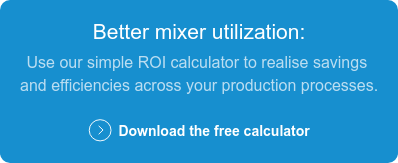Cleaning is a necessary evil endured by all sports nutrition and dietary supplement manufacturers. Regular changeovers to accommodate the wide range of products you produce means cleaning time starts to add up.With fixed mixers, the more time you spend cleaning, the less time you spend manufacturing. What if you could reduce the need to clean and enhance your production line capacity as well? How much more product could you produce?
In-Line Processing Decreases Production Time
Your last recipe run is complete and the product has cleared the line, it is packaged and ready to go. Now it’s time to clean down all those tricky pipes and fixed pieces of machinery so you can process the next recipe.
One of the major drawbacks with in-line production is that you can’t do anything until your machinery is completely clean. And that could take quite some time. We have experienced food manufacturers spending up to 20% of their production time cleaning their equipment.
This represents significant downtime for a sports nutrition manufacturer and means your equipment spends a good deal of time standing idle resulting in a low Overall Equipment Effectiveness score.
In comparison to other manufacturing facilities with leaner production processing in place, your facility’s productivity is way off the mark.
Some businesses try to take cleaning shortcuts by using these less-than-ideal alternatives such as:
Risky Cleaning Solution #1 - White to Black Production
Some manufacturers try to avoid cleaning after every recipe change by using ‘white to black’ manufacturing. For example, a sports nutrition manufacturer might start the day with a vanilla-based recipe, moving through the fruit recipes to end on chocolate. Because each subsequent recipe has a stronger taste than the previous one there’s no noticeable transfer of flavour.
The major problem with this approach is that your product won’t exactly match the ingredients listed on the label. In line with Food Standards legislation. Whatever is in the product should also be included on the label. Get caught out and you could be facing large fines and reputational damage.
Alternative Cleaning Solution #2 - Flushing
Another way to try to save time is to flush the production system with a cheap base material to remove the last product from the system.
The Flaw
Whatever you use to perform a flush-through, no matter how low the cost of the product, it’s still waste and the costs can quickly add up. In addition, allergenic ingredients may not be completely removed posing a risk to your customers and your business.
Another allergen challenge is that used flushing materials need to be identified, handled and stored in the same way as the original allergen that the flushed materials could contain. This means keeping track of and ensuring you apply the same allergen controls to another batch of ingredients.
Fixed Mixers Mean More Cleaning
So if the only way forward is to clean, then consider this. Big fixed mixers might blend ingredients quickly but they take a considerable amount of time to wash. Add allergenic ingredients to the mix and your clean times can spiral as you delve into every crevice to ensure your production line is clinically clean.
Products containing allergenic ingredients require a full clean-down after every recipe changeover. Cleaning validation should also take place to ensure no risk of cross-contamination. As these two stages take place, you’re left tapping your foot as you wait for production to start up again.
Not only that but in addition to the lost time, cleaning your equipment means significant costs in terms of water, cleaning products, energy and manpower. All of which eats into your bottom line.
Turn Cleaning Time Into Production Time
Understanding how long you spend on cleaning is the first step in addressing the problem. Simply add a few of your figures to our ROI calculator to find out how much time you’re wasting over a year and what this represents in lost time, cost, and additional capacity.
The next stage is deciding how to claw back a lot of that cleaning time and use it to make more product. All this requires is a switch to a more flexible, efficient manufacturing system that reduces cleaning downtime. Just think how much capacity that would add to your plant.
Lean Production Leaves In-Line in the Dust
As a modern sports nutrition manufacturer, you know that operating lean is the way to generate more profit. Intermediate Bulk Container (IBC) manufacturing systems provide a cost-effective way to add flexibility to your production line. Because the mixing is completed in-bin, the mixer doesn’t come into contact with the product and cleaning time is minimised.
This allows different products to be mixed one after the other with only a break to switch a blended IBC for an unmixed one. The used IBC is cleaned offline while a fresh IBC is attached to the mixer enabling continuous production.
If your products are particularly sticky and have long cleaning times or require enhanced validation to ensure complete hygienic cleaning standards have been met, you can still continue to manufacture. All the value-adding process steps can continue to operate throughout the shift without any downtime whilst the non-value-adding activities take place offline. On this basis, IBCs become a worthwhile investment.
If your productivity levels are a washout thanks to cleaning downtime, see what you could be missing out on. Download our ROI calculator and take the first step to improved productivity.
Topics:
Sports Nutrition.webp?width=697&height=418&name=Actual-Cleaning-hygiene-blog8-image%20(1).webp)
.png?width=600&height=100&name=SportsNutrition-Production%20(1).png)
